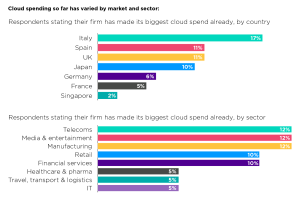Don’t get stuck in the slow lane as adopters race ahead
As a follow-up to our Cloud Research Report 2022, we wanted to explore some of its nuances and implications in more detail. In this blog, we consider the impact of the recent pandemic on cloud migration and ask if there is a resulting split between fast and slow adopters.
The pandemic accelerated the digital transformation plans of organisations, taking them from a walking pace to a fast gallop practically overnight. One of the drivers was the need to provide remote workers with immediate and effective access to essential applications.
Some 38% reported that their journey to cloud implementation had been sped up by the pandemic, fitting the expected pattern. Many said that it had forced them to revise or even completely rethink their existing cloud plans. But a similar group, 31%, said COVID had slowed their cloud momentum.
The survey reveals a geographic split, with a marked contrast between northern Europe and the southern region. The UK, France and Germany all had more respondents reporting a COVID-driven slowdown of migration than an acceleration, a situation mirrored in Singapore. Italy and Spain, conversely, had their cloud journey sped up by the pandemic, as did Japan.

When respondents are divided by sector rather than nationality, another story emerges. Perhaps unsurprisingly, the travel, transport and logistics industries slowed their cloud moves more than increased them during the crisis. Media and entertainment players reflected the same pattern. On the other hand, digital infrastructure companies forged on with their cloud plans, albeit with revised strategies, as did manufacturers, while those in financial services and retail were pretty evenly split between accelerators and deferrers.
The concern that underpins all these figures is evident. COVID created a twin-track cloud migration race, with some having used it as an opportunity to leapfrog rivals, while for others, it has been the cause of a risky hiatus. Will those in the slow lane now find it hard to catch back up? What price will the global digital economy pay for this gulf between fast and slow?
There are options for those who have slowed down their pace but want to catch up again. Step one must rekindle a commitment to cloud migration that spans the whole organisation from c-suite to ground level. Next is to deploy the agile infrastructure that will let them accelerate back to where they should be. This is no time to get stuck at the back of the pack while competitors eye up the victory tape.
Learn more and develop your migration strategy by reading our full Cloud Research Report 2022.
What's your goal today?
1. Are you on the Colt IQ network?
Our network connects over 31,000 buildings worldwide powering companies such as Hitachi, Atos, Forbes, Arthur D Little, Brussels Airlines and thousands of others. Find out if you're Colt connected now.
2. Learn about digital infrastructure
We've written thousands of guides and white papers, regularly publish content on our blog and host regular events on everything from enterprise network connectivity, to cloud, digital transformation and the hybrid workforce.
3. Join our team
To learn more about joining our team of over 5000 people around the world, and to browse our current open roles visit https://careers.colt.net/.

